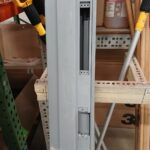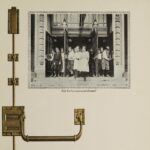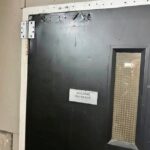Published here with permission from Safe Glass Consulting (click here to download a PDF reprint).
When we send our children off to school, we trust that the teachers and administrators responsible for them will do everything reasonably possible to keep them safe. For that reason, school design and construction is one of the most highly regulated niches in the construction industry.
In addition to requiring schools to comply with the same building codes as any other building, many states have enacted a spectrum of regulations specifically applicable to schools, ranging from a few specific provisions to whole new school building codes. Over the years, however, ignorance and misapplication of the interrelated provisions regarding fire safety and impact resistance in window and vision panel applications have allowed a serious danger to hide in plain sight and its name is “wired glass”.
We’ve all seen wired glass. It’s that institutional-looking product with a diamond or square-shaped grid of wire embedded in the glass. Many, many years ago, wired glass was commonly used in certain doors or windows to comply with fire safety provisions, which require doors or windows that communicate between specific fire separation areas to be “fire-rated”, meaning they have to resist or retard the spread of smoke or flame for a specific period of time. The sole purpose of the wire was to hold the glass shards together when the heat of a fire broke the glass. Keeping the broken shards from falling to the ground helped slow or stop the spread of smoke and flame from one specific area of a building to another. In the 1960s and early 70s, wired glass was the only glass product that was fire-rated. If a designer wanted glass in a fire-rated application, they had to specify wired glass.
Fire safety is not the only concern in specifying glass products in a building design, however. An equally important goal, especially in a building designed to be used by children, is impact resistance. Contrary to popular belief, wired glass is only about half as strong as ordinary window glass. The appearance of the wire in the glass, however, gives the impression to the uninitiated that the glass is a safety or a security glass. In reality, wired glass is not a safety glass at all and actually breaks with much less force than it takes to break ordinary glass, not to mention laminated or tempered glass, which are many, many times more impact-resistant than wired glass.
The dirty secret of wired glass is that when it does break, it causes horrific injuries. The wire in the glass grabs onto human flesh like teeth or the barb on a fishing hook, causing severe damage to muscles, ligaments, tendons, nerves and blood vessels when a victim attempts to remove his limb. Thus, wired glass in a door’s vision panel will break with only half the force that ordinary glass (non “safety glass”) can withstand but cause injuries exponentially worse.
Thirty-five years ago, the Consumer Product Safety Commission (CPSC) drafted federal safety glazing standards which contained common sense impact resistance requirements. Foreign wired glass manufacturers however, lobbied for an exception from impact resistance standards for wired glass used in fire-rated doors. The CPSC granted a 2-1/2 year temporary exemption for wired glass to allow manufacturers to develop a fire-rated product that would meet impact standards. Instead of improving their product, the manufacturers sued the CPSC and asked a federal court to strike down the new impact standards. The court declined but found that the 2-1/2 year exemption period for wired glass was arbitrary and invited the CPSC to reconsider the issue and support any wired glass exemption period with appropriate evidence. Instead, the CPSC abandoned any effort to regulate fire-rated wired glass and simply eliminated the termination date for the wired glass exemption, effectively rendering it permanent.
Thus exempted from federal regulation for impact safety, regulation of wired glass in fire doors in impact-prone locations was left to local building codes, many of which merely accepted a voluntary consensus standard, drafted in large part by the wired glass industry. That standard, rejected by the CPSC, requires fire-rated glass to withstand only the force generated by a child under five. Some of the wired glass sold in the U.S. market cannot even pass that test. Compounding the problem, many building professionals failed to understand or forgot over time that the exemption from the federal impact-safety standard for wired glass is actually very narrow. It applies only to wired glass: 1) in doors, 2) that are used to slow the passage of fire, and, 3) where the use of wired glass in that specific location is required by federal, state, or local law. Only if all three criteria are met can a piece of wired glass escape the impact safety requirements of the federal standard. Much of the wired glass installed in schools before 2003 (and other buildings before 2006) fails to satisfy these criteria.
The irony is that more suitable, much safer alternative products already existed by the 1970s and 1980s. Building designers continued to specify wired glass, however, continuing to do what they had always done or mistakenly specifying it in non-fire-rated applications. In 2003, the International Building Code (IBC) was finally amended to bar traditional wired glass in doors and other potential impact areas in new schools and daycare centers. The 2003 edition of the code also effectively required impact-resistant glazing in any gymnasium or other athletic facility, whether or not the gym is in a school. In 2006, the IBC extended the ban on traditional wired glass to all impact-prone locations in any new building.
That still leaves miles and miles of wired glass in schools built before 2003. As many school districts have learned the hard way, though, traditional wired glass is never appropriate in areas where children could come into contact with it, regardless of what a building code says. The fact that wired glass is “allowed” in an existing building because the code does not require its removal is not a defense to a negligence lawsuit. That is so because building codes are not cookbooks. They are an attempt to provide a broad, generally applicable reconciliation of sometimes conflicting standards and goals applicable to designing and building useful, aesthetically pleasing and safe buildings. Compliance with a building code does not mean a building is safe. Rather, it is the architect’s and builder’s job to use applicable codes as a tool, along with experience, specialized training and common sense, to design and build a facility that is “safe,” as defined by the specific project.
Any property owner is required to act with reasonable care to protect others from foreseeable dangers while using its property. In deciding what a reasonably careful school district should or should not do, the law will charge the school district’s employees with knowledge of the dangers of wired glass even if they are unaware of those dangers. That is so because a property owner must act reasonably in light of what it knew or should have known. It is virtually impossible today to plausibly claim ignorance of the dangers of wired glass in impact areas in light of the information available on the internet, in trade publications, and other sources, not to mention the number of injuries and six and seven figure verdicts and settlements that have resulted from those injuries.
School administrators and facilities management employees must educate themselves about the dangers of wired glass. A risk-and-code-compliance assessment performed by a qualified professional can then help them plan corrective measures. When an add-on product like an approved safety film, which costs a couple hundred dollars or less, can defuse the time bomb by making a wired glass window appropriately impact resistant, what possible explanation could there be for letting the bomb continue to tick?
Kenneth T. Lumb is a trial lawyer at Corboy & Demetrio in Chicago, Illinois. He has represented numerous victims of wired glass, including the family of a 20 year-old college student who died after falling out of a wired glass hallway window and a young man whose hand and arm were mutilated when they went through a wired glass vision panel in a school gymnasium door. Ken can be reached at 312-346-3191 or ktl@corboydemetrio.com.
© 2013 All content is the sole property of Safe Glass Consulting and may not be reproduced, published or distributed without the express written consent of Safe Glass Consulting, all rights reserved.
You need to login or register to bookmark/favorite this content.





Excellent article Lori. Do you think he would allow D&H magazine to reprint it? I knew about the CPSC basically outlawing wire glass but not the impasse that allowed to stick around for a couple of more decades. Is there an aftermarket fire rated film that can be added the existing wire glass in the field? That would help mitigate the safety issue, but at the same time confuse the fire rated glass issue as most of the wire glass from back then did not have an etched rating stamp on it, but I would assume the film would. Fire Door Inspectors beware.
At non rated openings, I would hope they would just change out the wire glass for safety glass.
Hi Jim –
I’m sure he’d be happy to have it printed in D&H. I’ll talk to him about it and put him in touch with Jess. There are several film products that can be applied to glass in a fire door. I’m working on a post that will include that information.
– Lori
Nice article, Mr. Lumb! You hit all the high points, including the actions by the CPSC that led to the explosion of the use of wired glass in architectural applications. You are correct that in 1977 the CPSC issued 16 CFR 1201.1(c) (1) that provided for the limited wired glass exemption. Unfortunately, the limitation was large enough to drive a truck through it, and no one from the agency enforced the limitation. Combined with the fact that the wired glass industry made sure they had several seats at the table on all the regulatory bodies, it is no wonder that true safety glass applications were never allowed to develop to be cost-competitive. Wired glass sold cheap, and the manufacturers knew their product was not safe for use in any application with exposure to human impact because it never met impact standards in any legitimate testing. The overseas wired glass cartel continued to market this stuff as safety glass because they made a lot of money and they had no one watching the hen house. American companies who had true safety glass products were simply shut out of the market. The 1960s, ’70s and ’80s saw record construction growth, particularly in new school construction. Every single one of those schools represented a bonus paycheck to the cartel. Every gymnasium, every hospital, every recreation center was filled with this “fake” safety glass that did anything but protect our children.
Thankfully, through Mr. Abel’s tough research and persistence, and my own tenacity, in 2003 we succeeded in changing the Oregon Structural Specialty Code to eliminate the use of wired glass in hazardous locations subject to human impact in all educational facilities, gymnasiums, athletic facilities, and commercial structures in the state of Oregon. No other state in the country had made that step, and a year later Oregon extended the limitation to all building uses in conjunction with the adoption of the updated Oregon Building Code. Unfortunately, the new code was not retroactive to existing locations of wired glass other than requiring replacement glass to meet the new standard. As you noted, we took our fight to the ICC and won new code provisions in 2003 and those were extended further in 2006. Any state adopting the new ICC code provisions would then be subject to the new regulations. It was an important victory, but much work lies ahead.
As you aptly pointed out, none of these code provisions are retroactive. Until schools around the country realize they are paying out more in claims than it would cost to change out existing applications of wired glass, the time bomb will continue to tick. CPSC surveillance data was never specifically coded for wired glass injuries, so it made it difficult to do follow-back studies and determine which glass injuries being presented in hospitalizations and physician visits were related to wired glass. If schools across the country were required to report such data to their state departments of education, insurance carriers and parents will start to take notice and you may see some efforts at addressing these retroactive applications.
The largest of our local school districts in our community changed out their wired several years ago when Oregon adopted the new building codes because the school boards and administrators put the safety of the children in their care at the top of their agenda, no matter what the cost. These are difficult choices because school districts are facing budget cuts all across the country, but one injured child is one too many, in my humble opinion. Our local districts had seen wired glass injuries to students in the past, and it was a sight that one teacher told me he would never forget because it was such a traumatic injury. I testified in a court case in 2011 where a jury found a large school district in Oregon (one that refused to invest in changing out the old glass) was at fault and liable for several thousand dollars to a young student injured by an existing application of wired glass. Injuries and payments like these will continue to plague districts until they address this ticking time bomb.
It’s too bad the wired glass cartel could not be forced to dig into their own pockets to assist school districts in their efforts to bring schools up to safety standards. After all, their desire to make money at the expense of human safety is what got us here in the first place.